JAIPUR
The capital city of the state of Rajasthan is popularly known as the
‘pink city’ because of the pink paint applied to the buildings in
its old walled city. (In Rajput culture, pink was traditionally a colour
associated with hospitality). In contrast to the cities on the Ganges
plain, Jaipur has broad avenues and a remarkable harmony. The city sits
on a dry lake bed in a wild and somewhat arid landscape, surrounded by
barren hills surmounted by fortress and crenellated walls. Jaipur long
ago outstripped the confines of its city wall yet retains a less crowded
and more relaxed atmosphere than its large size and population might
suggest.
History
The city owes its name, its foundation and its careful planning to
the great warrior-astronomer Maharaja Jai Singh II (1699-1744). His
predecessors had enjoyed good relations with the Mughals and Jai Singh
was careful to culture this alliance.
In 1727, with Mughal power on the wane,
Jai Singh decided the time was ripe to move down from his somewhat
cramped hillside fortress at nearby Amber to a new site on the plains.
He laid out the city, with its surrounding walls and six rectangular
blocks, according to principles of town planning set down in the Shilpa-
Shastra, an ancient Hindu treatise on architecture. In 1728, he built
the remarkable observatory which is still one of Jaipur’s main
attractions.
Orientation
The walled ‘pink city’ is in the north –east of Jaipur, while
the new parts have spread to the south and west. The city’s main
tourist attractions are in the old part of town. The principal shopping centers
in narrow alleys in India and elsewhere in Asia, this one is
broad and open. All seven gates into the old city remain but,
unfortunately, much of the wall itself has been torn down for building
material. There is now a preservation order in the remainder.
Old City
The old city is partially encircled by a crenellated wall with seven
gates- the major gates are Chandpol, Ajmeri and Sanganeri. Broad
avenues, over 30 metres wide, divide the pink city into near rectangles.
It’s an extremely
colourful city and, in the evening light, the pink and orange buildings
have a magical glow which is complemented by the brightly clothed
Rajasthanis. Camel-drawn carts are a characteristic of Jaipur’s
passing street scene, along with the ubiquitous Ambassador taxis and the
more modern Maruti vans and cars, all jostling for space with the
innumerable tempos, bicycles, auto-rickshaws and pedestrians.
The major landmark in this part of town is the
Iswari Minar Swarga Suri, the Minarets Piercing Heaven, near the
Tripolia Gate, which was built to overlook the city.
The main bazaars in the old city are Johari Bazaar
(for jewellery and saris), Tripolia Bazaar (for brassware, carvings and lacquer ware), Bapu Bazaar (for perfumes and textiles) and Chandpol
Bazaar (for modern trinkets and bangles).
Hawa Mahal
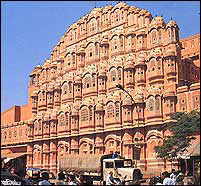 Built in 1799, the Hawa Mahal, or Palace of the Winds, is one of
Jaipur’s major landmarks, although it is actually little more than a
façade. This five-storeys building, which looks out over the main
streets of the old city, is a stunning example of Rajput artistry with
its pink, semi octagonal and delicately honeycombed sandstone windows. It
was originally built to enable ladies of the royal household to watch
the everyday life and processions of the city. You can climb to the top
of the Hawa Mahal for an excellent view over the city. The palace was
built by Maharaja Sawaj Pratap Singh and is part of the City Palace
complex. There’s a small archaeological museum on the same site.
Built in 1799, the Hawa Mahal, or Palace of the Winds, is one of
Jaipur’s major landmarks, although it is actually little more than a
façade. This five-storeys building, which looks out over the main
streets of the old city, is a stunning example of Rajput artistry with
its pink, semi octagonal and delicately honeycombed sandstone windows. It
was originally built to enable ladies of the royal household to watch
the everyday life and processions of the city. You can climb to the top
of the Hawa Mahal for an excellent view over the city. The palace was
built by Maharaja Sawaj Pratap Singh and is part of the City Palace
complex. There’s a small archaeological museum on the same site.
Entrance to the Hawa Mahal is from the rear of the
building. To get there, go back to the intersection on your left as you
face the Hawa Mahal, turn right and then take the first right again
through an archway. It’s signposted and open daily from 9 am to 4:30
pm.
City Palace
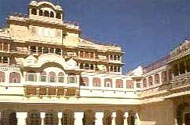 In the heart of the old city, the City Palace occupies a large area
divided into a series of courtyards, gardens and buildings. The outer
wall was built by Jai Singh but other additions are much more recent,
some dating to the start of this century. Today, the palace is a blend
of Rajasthani and Mughal architecture. The former maharaja still lives
in part of the palace.
In the heart of the old city, the City Palace occupies a large area
divided into a series of courtyards, gardens and buildings. The outer
wall was built by Jai Singh but other additions are much more recent,
some dating to the start of this century. Today, the palace is a blend
of Rajasthani and Mughal architecture. The former maharaja still lives
in part of the palace.
The seven-storey Chandra Mahal is
the centre of the palace and commands fine views over the gardens and
the city. The ground and 1st floor of the Chandra Mahal form
the Maharaja Sawai Man Singh II Museum. The apartments are
maintained in luxurious order and the museum has an extensive collection
of art, carpets, enamelware and old weapons. The paintings include
miniatures of the Rajasthani, Mughal and Persian schools. The armoury
has a collection of guns and swords dating back to the 15th
century, as well as many of the ingenious and tricky weapons for which
the warrior Rajputs were famous. The textile section contains dresses
and costumes of the former maharajas and maharanis of Jaipur.
Other
points of interest in the palace include the Diwan-i-Am, or Hall
of Public Audiences, with its intricate decorations and manuscripts in
Persian and Sanskrit, and the Diwan-i-Khas, or Hall of Private
Audiences, with a marble-paved gallery. There is also a clock tower and
the newer Mubarak Mahal.
Outside the buildings, you can see a large silver vessel
which a former maharaja used to take drinking water with him to England.
The palace and museums are open daily, except on public holidays,
between 9:30 am and 4:45 pm.
Jantar Mantar
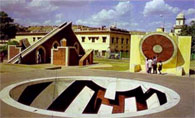 Adjacent to the entrance to the City Palace is the Jantar Mantar, or
observatory, begun by Jai Singh in 1728. Jai Singh’s passion for
astronomy was even more notable than his prowess as a warrior and,
before commencing construction, he sent scholars abroad to study foreign
observatories. The Jaipur observatory is the largest and the best
preserved of the five he built, and was restored in 1901. Others are in
Delhi (the oldest, dating from 1724). Varanasi and Ujjain. The fifth,
the Muttra observatory, has now disappeared.
Adjacent to the entrance to the City Palace is the Jantar Mantar, or
observatory, begun by Jai Singh in 1728. Jai Singh’s passion for
astronomy was even more notable than his prowess as a warrior and,
before commencing construction, he sent scholars abroad to study foreign
observatories. The Jaipur observatory is the largest and the best
preserved of the five he built, and was restored in 1901. Others are in
Delhi (the oldest, dating from 1724). Varanasi and Ujjain. The fifth,
the Muttra observatory, has now disappeared.
At first glance, Jantar Mantar appears to be just a curious
collection of sculptures but, in fact, each construction has a specific
purpose, such as measuring the positions of stars, altitudes and
azimuths, or calculating eclipses. The most striking instruments is the
sundial with its 30- metre-high gnomon. The shadow this casts moves up
to four metres an hour.
Central
Museum
This dusty collection is housed in the architecturally impressive
Albert Hall in the Ram Niwas Gardens, south of the old city. The upper
floor contains portraits of the Jaipur maharajas and many other
miniatures and artwork. The ground floor has a collection of costumes
and woodwork from different parts of Rajasthan and a description of the
people and life in the rural areas of the state. The collection, which
was started in 1833, is also notable for its brassware, jewellery and
pottery. It is open daily from 10 am to 4:30 pm.
Other
Attractions
The Ram Niwas Gardens also has a zoo with unhappy-looking animals
and a small crocodile breeding farm. Jaipur has a modern art gallery
in the ‘theatre’ near the zoo. To visit it you need to make
enquiries as it’s normally locked. Kripal Kumbh, where
Jaipur’s famous blue pottery is made, can also be visited.
The Museum of Indology
is an odd private collection of folk art objects and other bits an
pieces of interest- there’s everything from a map of India painted on
a rice grain, to manuscripts (one written by Aurangzeb), jewellery,
fossils, coins, old currency notes, clocks, watches and much more. The
museum is in fact in a private house (although the living quarters seem
to have been swallowed up by the collection), and is signposted off
Nehru Marg, south of the Central Museum. The owner out of his
collection- the entry fee has risen steeply and some of the exhibits are
offered for sale. It’s open daily from 10 am to 5 pm.
Finally, if you go to only one
Hindi movie while you’re in India, see it at the Raj Mandir.
This opulent and extremely well-kept cinema is a Jaipur tourist
attraction in its own right and is always full, despite its immense
size.
AMBER FORT
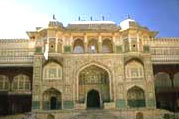 Situated about 11 km out of Jaipur on the Delhi to Jaipur road, Amber
was once the ancient capital of Jaipur state. Construction of the
fortress- places was begun in 1592 by Raja Man Singh, the Rajput
commander of Akbar’s army. It was later extended and completed by the
Jai Singhs before the move to Jaipur on the plains below. The fort is a
superb example of Rajput architecture, stunningly situated on a hillside
and overlooking a lake which reflects its terraces and ramparts.
Situated about 11 km out of Jaipur on the Delhi to Jaipur road, Amber
was once the ancient capital of Jaipur state. Construction of the
fortress- places was begun in 1592 by Raja Man Singh, the Rajput
commander of Akbar’s army. It was later extended and completed by the
Jai Singhs before the move to Jaipur on the plains below. The fort is a
superb example of Rajput architecture, stunningly situated on a hillside
and overlooking a lake which reflects its terraces and ramparts.
An imposing stairway leads to the Diwan
–i-Am, or Hall of Public Audiences, with a double row of columns
and latticed galleries above. Steps to the right lead to the small Kali
Temple. There is also the white marble Sila
Devi Temple.
The maharaja’s apartments are on the higher terrace –
you enter through a gateways decorated with mosaics and sculptures. The Jai
Mandir, or Hall of Victory, is noted for its inlaid panels and
glittering mirror ceiling. Regrettably, much of this was allowed to
deteriorate during the ‘70s and 80s’ but restoration work proceeds.
Opposite the Jai Mandir is the Sukh Niwas, or Hall of Pleasure, with an ivory – inlaid sandalwood
door, and a channel running right through the room which once carried
cooling water. From the Jai Mandir you can enjoy the fine views from the
palace ramparts over the lake below.
Nahargarh
 Nahargarh, also known as the Tiger Fort, overlooks the city from a sheer
ridge to the north, and is floodlit at night. The fort was built in 1734
and extended in 1868. An 8km road runs up through the hills from Jaipur,
and the fort can be reached along a zigzagging 2km path.
Nahargarh, also known as the Tiger Fort, overlooks the city from a sheer
ridge to the north, and is floodlit at night. The fort was built in 1734
and extended in 1868. An 8km road runs up through the hills from Jaipur,
and the fort can be reached along a zigzagging 2km path.
Jaigarh
The imposing Jaigarh, built in 1726 by Jai Singh, was opened to the
public in mid-1983. The fort was never captured and so has survived
virtually intact through the centuries. It’s within walking distance
of Amber and offers a great view over the plains from the Diwa Burj
watchtower.
Festivals
Jaipur’s elephant festival is held in early to mid-March (depending on
the lunar calendar) and is actually part of the Holi Festival.
Things to
Buy
Jaipur is well known for precious stones, which seem cheaper here
than elsewhere in India, and is even better known for semi-precious
stones. For precious stones, find a narrow alley called Haldion Ka Rasta
off Johari Bazaar (near the Hawa Mahal). Semi-precious stones are sold
in another alley, called the Gopalji Ka Rasta, on the opposite side of
the street. There are many shops here which offer bargain prices, but
you do need to know your gems.
For fixed-price khadi
(homespun cloth) and cotton, there are two good places to try. For khadi,
the Khadi Gramodyog shops are the best bet. These governments –run
shops have a wide range and everything is handmade. There’s one just
inside Sanganeri Gate in Bapu Bazaar, and another at the Panchbatti
intersection.
Getting
There & Away
Air: The Indian Airlines office in Jaipur is on Tonk Rd. The Air
India office is in Rattan Mansion on MI Rd. Numerous international
airlines have offices in Jaipur Towers on M I Rd.
Bus:
Buses to all Rajasthan’s main population centres and to Delhi and Agra
are operated by the Rajasthan State Transport Corporation from the Bus
terminal.
Train:
Many of the lines into Jaipur have been converted to broad gauge. As
other parts of the state’s railway are converted expect disruptions to
services.
AROUND
JAIPUR
There are several attractions around Jaipur, including some on the
road between Jaipur and Amber. Jaipur tours usually stop at some of
these sites on the way to or front Amber.
Amber
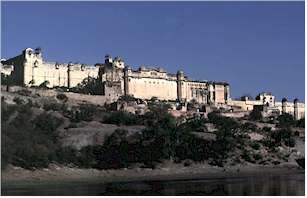 Situated about 11 km out of Jaipur on the Delhi to Jaipur road,
Amber was once the ancient capital of Jaipur state. Construction of the
fortress-palace was begun in 1592 by Raja Man Singh, the Rajput
commander of Akbar’s army. It was later extended and completed by the
Jai Singhs before the move to Jaipur on the plains below. The fort is a
superb example of Rajput architecture, stunningly situated on a hillside
and overlooking a lake which reflects its terraces and ramparts.
Situated about 11 km out of Jaipur on the Delhi to Jaipur road,
Amber was once the ancient capital of Jaipur state. Construction of the
fortress-palace was begun in 1592 by Raja Man Singh, the Rajput
commander of Akbar’s army. It was later extended and completed by the
Jai Singhs before the move to Jaipur on the plains below. The fort is a
superb example of Rajput architecture, stunningly situated on a hillside
and overlooking a lake which reflects its terraces and ramparts.
You can climb up
to the fort from the road in 10 minutes, and cold drinks are available
within the palace if the climb is a hot one.
An imposing stairway leads to the Diwan-i-
Am, or Hall of Public Audiences, with a double row of columns and
latticed galleries above. Steps to the right lead to the small Kali
Temple. There is also the white marble Sila Devi Temple.
The
maharaja’s apartments are on the higher terrace- you enter through a
gateway decorated with mosaics and sculptures. The Jai Mandir, or
Hall of Victory, is noted for its inlaid panels and glittering mirrors
ceiling. Regrettably, much of this was allowed to deteriorate during the
‘70s and 80s but restoration work proceeds. Opposite the Jai Mandir is
the Sukh Niwas, or Hall of Pleasure, with an ivory-inlaid
sandalwood door, and a channel running right through the room which once
carried cooling right through the room which once carried cooling water.
From the Jai Mandir you can enjoy the fine views from the palace
ramparts over the lake below.
Gaitor
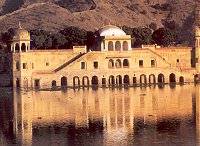 The cenotaphs of the royal family are at Gaitor, 6.5 km from
Jaipur on the road to Amber. The white marble cenotaph of Maharaja Jai
Singh II is the most impressive and is decorated with carved peacocks.
Next to it is the cenotaph of his son.
The cenotaphs of the royal family are at Gaitor, 6.5 km from
Jaipur on the road to Amber. The white marble cenotaph of Maharaja Jai
Singh II is the most impressive and is decorated with carved peacocks.
Next to it is the cenotaph of his son.
Opposite the cenotaphs
is the Jal Mahal (Water Palace) in the middle of a lake and
reached by a causeway. Or at least it was in the middle of a lake; the
water is now all but squeezed out by the insidious weed, water hyacinth.
There is another Royal Gaitor just outside the Jaipur city walls.
Tiger Fort
The Nahargarh Fort overlooks the city from a sheer ridge to the
north, and is floodlit at night. The fort was built in 1734 and extended
in 1868. An eight-km road runs up through the hills from Jaipur, and the
fort can be reached along a zigzagging two-km path.
Jaigarh Fort
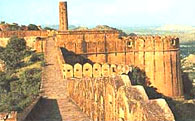
The imposing Jaigarh Fort, built in 1726 by Jai Singh, was only
opened to the public in mid-1983. It’s within walking distance of
Amber and offers a great view over the plains from the Diwa Burj
watchtower. The fort, with its water reservoirs, residential areas,
puppet theatre and the cannon, Jaya Vana, is open from 9 am to 4:30 pm.
Samode
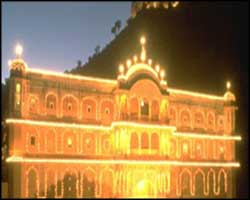 The small village of Samode is nestled amongst rugged hills about 50
km north of Jaipur, via Chomu. The only reason to visit it is if you can
afford to stay in the beautiful Samode Palace. Like the Samode
Haveli in Jaipur, this building was owned by the rawal of Samode. It’s
a beautiful building built on three levels, each with its own courtyard.
The highlight of the building is the absolutely exquisite Diwan-i-Khas,
which is covered with completely original painting and mirror work, and
is probably the finest example of its kind in the country.
The small village of Samode is nestled amongst rugged hills about 50
km north of Jaipur, via Chomu. The only reason to visit it is if you can
afford to stay in the beautiful Samode Palace. Like the Samode
Haveli in Jaipur, this building was owned by the rawal of Samode. It’s
a beautiful building built on three levels, each with its own courtyard.
The highlight of the building is the absolutely exquisite Diwan-i-Khas,
which is covered with completely original painting and mirror work, and
is probably the finest example of its kind in the country.
Galta
The temple of the sun god at Galta is 100 metres above the city to
the east, a 2.5 km climbs from the Surajpol. A deep temple-filled gorge
stands behind the temple and there are fine views over the surrounding
plain.
Sisodia Rani
Palace & Gardens
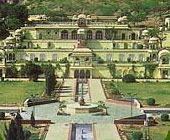
Six km from the city on the Agra road and surrounding by terraced
gardens, this palace was built for Maharaja Jai Singh’s second wife,
the Sisodia princes. The outer walls are decorated with murals depicting
hunting scenes and the Krishna legend.
Vidyadharji
ka Bagh
Nestled in a narrow valley, this beautiful garden was built in
honour of Jai Singh’s chief architect and town planner, Vidyadhar.
Balaji
The Hindu exorcism temple of Balaji is about 1.5 km off the Jaipur
to Agra road, about 1-˝ hours by bus from Bharatpur. The exorcisms are
sometimes very violent and those being exorcised don’t hesitate to
discuss their experiences. Buses leave for Balaji from the bus station
in Delhi.
Sanganer
The small town of Sanganer is 16 km south of Jaipur and is entered
through the ruins of two tripolias, or triple gateways. In
addition to its ruined palace, Sanganer has a group of Jain temples with
fine carvings to which entry is restricted. The town is noted for
handmade paper and block printing.





